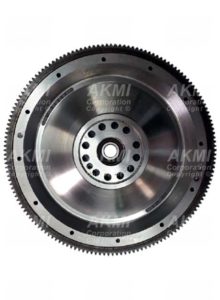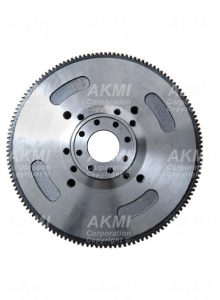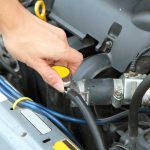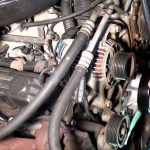Often referred to as being the same thing, flywheels and flexplates have similarities but are quite different.
 1. Flywheels are typically found on vehicles equipped with manual transmissions, while flexplates are used in vehicles with automatic transmissions.
1. Flywheels are typically found on vehicles equipped with manual transmissions, while flexplates are used in vehicles with automatic transmissions.
A manual transmission has a flywheel that is attached to the crankshaft and has a clutch disk in between the pressure plate and flywheel.
When someone presses the clutch, the throwout bearing is pushed in, which forces the pressure plate to stop applying pressure to the clutch disk.
As this happens, it stops receiving power from the engine.
So the gear shifts without damaging the transmission.
Once the operator/driver shifts into a new gear release the clutch pedal then the clutch disk is allowed to start receiving power from the engine once again.
Automatic transmissions eliminate the clutch and grinding.
Basically automating the shifting process so the driver does not have to worry about shifting gears while driving.
A flexplate is mounted to the crankshaft and connects the output from the engine to the input of a torque converter.
Torque converters replace the clutch of a manual transmission.
Allowing the load to be separated from the power source.
They are generally a type of fluid coupling that can multiply torque and is used in transferring rotating power from the prime mover (internal combustion engine or electric motor) to a rotating driven load. The torque converter is located between the flexplate and the transmission.
Flywheels, due to the friction process, are very thick, made of steel and are as heavy as they look.
Their lifecycle can outlast that of the clutch but will need resurfacing before installing a new clutch.
When they need do need replacing, you can typically get away with using an aftermarket replacement.
2. Flexplates are much thinner than a Flywheel
As well as the ring gear it uses to connect with the starter (depending on vehicle and engine size), and are much, much lighter.
This is due to the fluid coupling of the torque converter, which eliminates the grinding of a clutch.
The lighter, thinner metal frame has an ability to flex across its main axis – bending side to side (hence the name Flexplate) – taking up motion in the torque converter as the rotational speeds change.
The metal frame of the flexplate itself will have multiple machine-cut holes within the body of the plate.
One set of holes will look uniform and would be for mounting to the crankshaft.
The other holes are specific to the vehicle, torque converter set-up and potential weight balance of the flexplate.
No matter the car size, small economy size or heavy-duty truck.
If your vehicle has a manual transmission and you have to step on the clutch to shift gears, your vehicle has a flywheel as part of your transmission. If all you have to do is put the shifter in a drive (D) and step on the gas pedal, your vehicle has a flexplate.

3. Repair and replacement cost
If you have problems with your flywheel you probably have to replace them, but what it´s their costs?
The replacement of the flywheel can vary depending on the model and the quality, the prices are about 35$ and 400$. In our shop, we have a variety of flywheels for your comfort.
Those were some important facts about flywheels and flexplates.
Now, can I drive with a cracked flexplate?
Sure you can drive with a broken flexplate but is heavily dangerous.
And the sound of the broken part is terrible if you have a broken flexplate or flywheel you have to go to your mechanic immediately and change the part.





